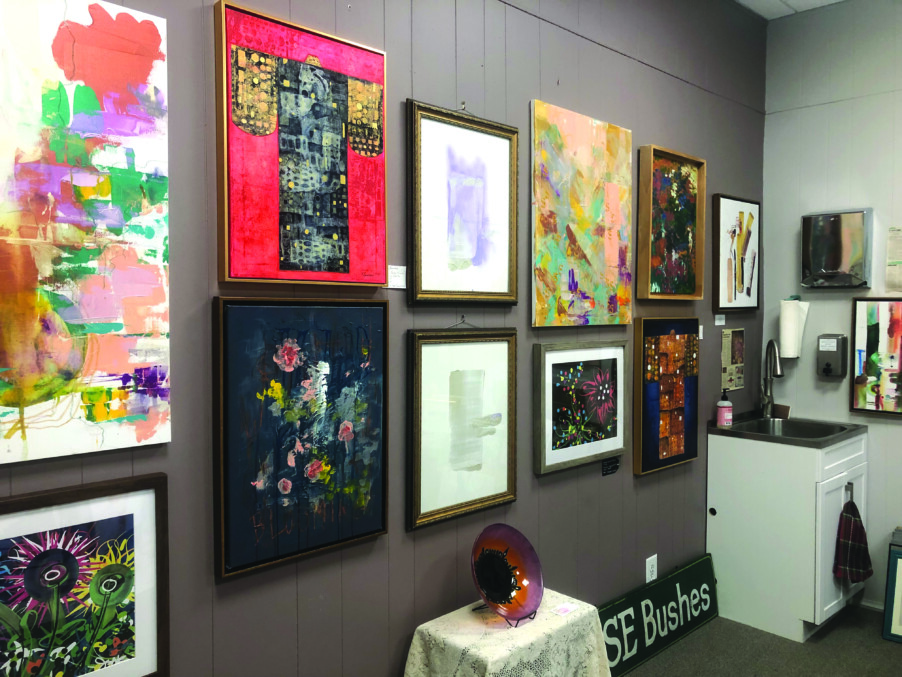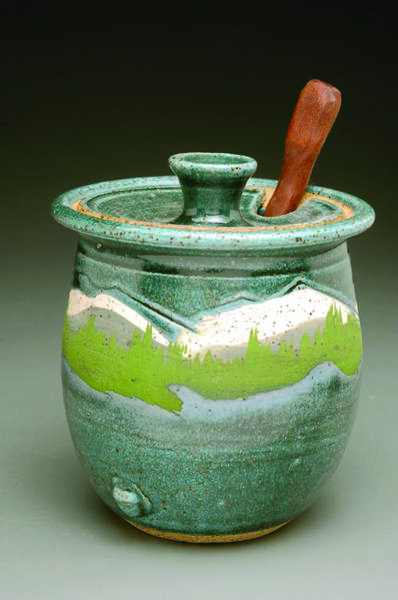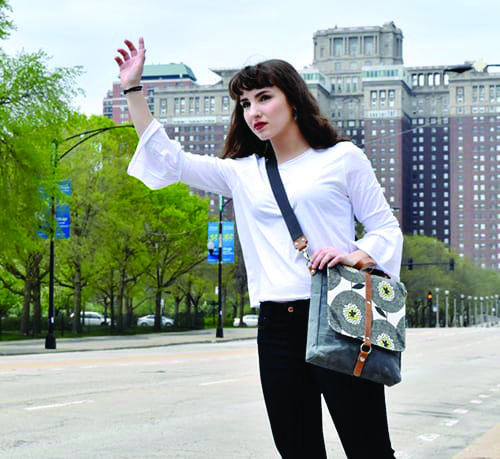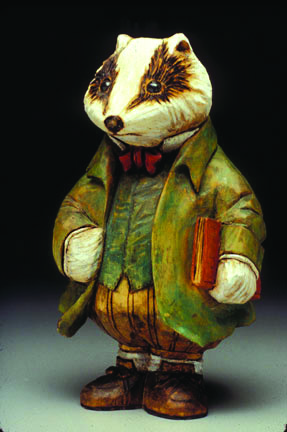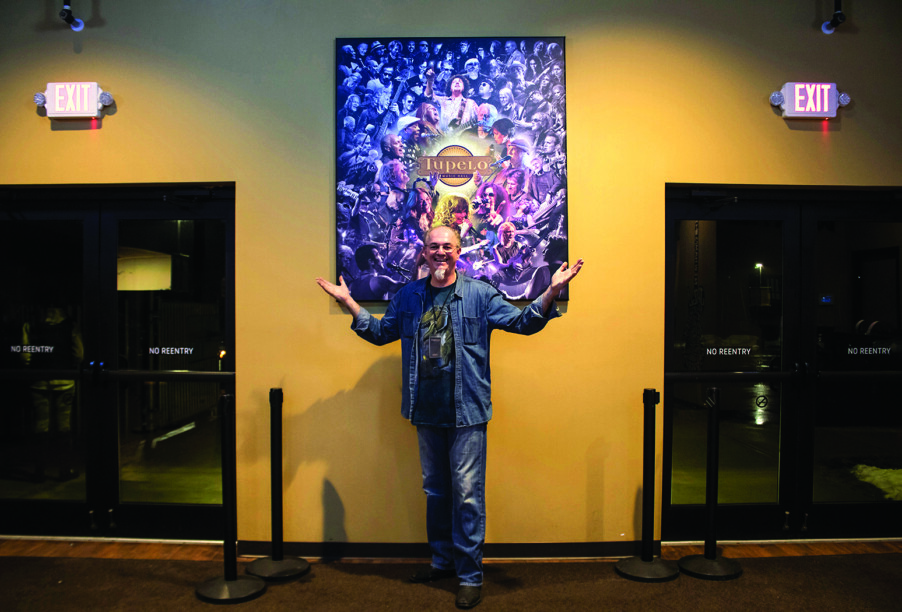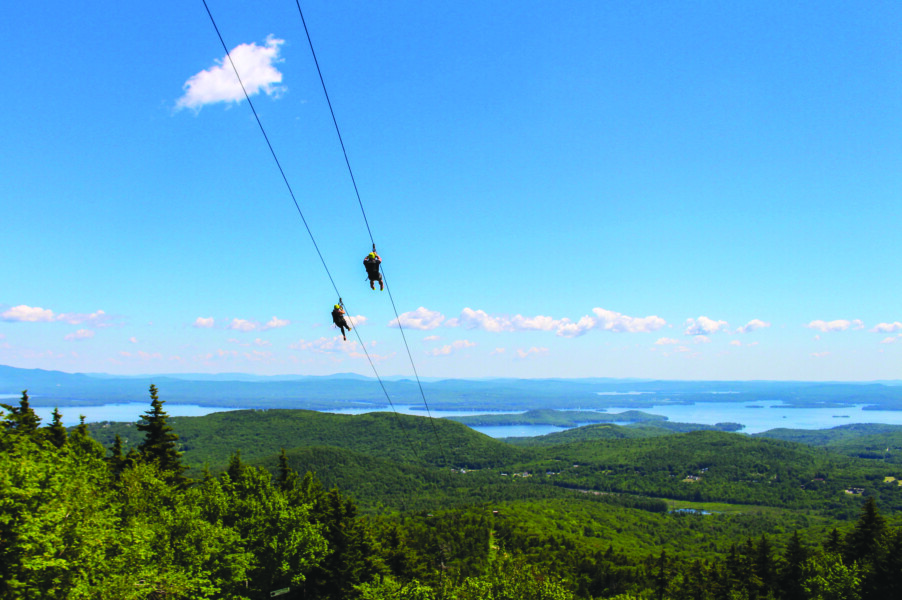Get a new view of the world while ziplining above the trees, soaring in a hot air balloon or parasailing over the water
You’ve seen New Hampshire’s forests, mountains and seacoast, but have you seen them from above? Get a new view with a relaxing flight in a hot air balloon, an adrenaline-filled zipline tour or a gentle but exhilarating parasail ride along the coast.
Hot air ballooning
Heading toward the sky in a hot air balloon is a much smoother and quieter ride than most people expect, says Tony Sica of High 5 Ballooning in Derry.
“When we launch, [passengers] don’t even know we’re leaving the ground,” Sica said. “There’s no g-force; we’re just gently drifting off the ground.”
For every launch, riders meet half an hour before sunrise at 15 Ermer Road in Salem, then Sica and his crew pick one of five launch locations, depending on which way the wind is blowing.
“We’re trying to launch from a location that’s going to take us into a decent landing,” Sica said. “You land wherever the wind takes you.”
Once they arrive at the launch site, anyone who wants to help prepare the balloon for inflation is welcome to. Then the gentle ascent begins.
“There’s absolutely zero motion — unless I’m dancing, which I do sometimes,” Sica joked.
The balloon stays right above the trees and maintains a profile up and down the treeline, which Sica referred to as contour flighting. A three- to five-mile ride is typical, though Sica said he’s gone as far as eight miles when the wind is moving quickly. But he prefers to stick to that three to five miles that he says he knows like the back of his hand, because that takes his passengers over the most scenic areas.
“We try to keep it as natural as possible,” Sica said. “When we go over water or wetlands, I’ll get right down in there … so people can take those great reflection [photos].”
There’s also a crew following the passenger balloon that takes photos along the way. Sica said he likes to go for “the money shot,” flying over Melville Lake or Alexander Pond. If they’re in the smiley face balloon — his most popular option — he’ll spin it around and bring the basket down to the water so the crew behind him can capture both the balloon and its reflection on the water.
Once they land, passengers can help squeeze the air out of the balloon if they want, and then they head with the ground crew back to the meeting site for a Champagne celebration. The flight is an hour, but the whole experience is about two and a half hours, Sica said.
For people who think they have a fear of heights, Sica said most actually have a fear of falling, and since you’re surrounded by the basket’s four solid walls, that fear usually isn’t triggered.
He said the most scared passenger he’s ever flown, Paul, got in the basket and the whole thing was shaking because he was so nervous. Two months later, Sica got a letter from Paul’s wife thanking him for helping him overcome his fears — they’d just been on their honeymoon, where they went parasailing, and Paul had gone skydiving too.
“Another success story,” Sica said.
Plus, ballooning is the safest form of aviation in the world, he said. Any accident has been pilot-related, “people doing stupid things,” he said. “You have to be willing to walk away [if conditions aren’t safe]. Don’t ever put your wallet in front of your safety.”
Sica has owned High 5 Ballooning since 1999; when he opened, there were 27 ballooning companies in New Hampshire, and now there are three.
“I can’t even tell you how busy we are,” he said. “It’s insane.”
High 5 is currently booking into September and October. Sica can take as many as eight passengers; if you want a private flight, you can pay the $1,600 to be alone (you’re paying for all eight spaces), but Sica said most people realize it’s more fun with a group of people, even if they’re all strangers at the beginning.
“It’s an adventure sport and part of that adventure is sharing the experience with other people,” he said.
High 5 Ballooning
Where: 4 Joseph St., Derry (office); meeting place is 15 Ermer Road in Salem
When: Half an hour before sunrise, seven days a week
Cost: $200 per person. Prices are subject to increase for private flights, for passengers weighing more than 200 pounds, and for couples who weigh more than a combined 400 pounds.
To book a flight, call 893-9643 or visit high5ballooning.com.
A&A Balloon rides
Where: 7 E. Derry Road, Chester (office); meeting place is 15 Ermer Road in Salem
When: Half an hour before sunrise
Cost: Sunrise flights are $250 for adults and $125 for children who are 12 or older or who weigh more than 100 pounds. The cost includes Champagne, crackers and cheese for after the flight. Private flights and events are also available. Costs are subject to increase for passengers weighing more than 200 pounds.
To book a flight, call 432-6911 or visit balloonridesnh.com.
Ziplining
For a more intense adrenaline rush above the treetops, ziplining will get you from Point A to Point B much faster than a hot air balloon floating through the sky.
“The zipline is great for people who have the need for speed,” said Jen Karnan, who started working at Gunstock Mountain Resort as a zipline instructor back in 2012 and is now the communications coordinator. “You can get up to 65 mph. … It gives you that wind in the hair sensation.”
But there’s still an element of control, she said — there’s a brake, so you’re in charge of your own speed.
“We actually get a lot of people who come up here to conquer their fear of heights,” Karnan said. “They go from ‘I can’t do this’ to ‘I can’t wait to do this again!’”
Gunstock’s guides get you started on the ground level of the main lodge, going through safety instructions while you put on your helmet and harness and pick up your trolley. The trolley weighs about 18 pounds and is the main piece of equipment you’ll be suspended from (or carrying in a backpack) during the tour. Athleticism is not required, but you do need to be able to walk up to 3/4 of a mile and ascend two 50-foot staircases while carrying the trolley, according to the Gunstock website.
Gunstock’s zipline tour has five lines, starting with a 45-foot demo line, then a 450-foot training line, which allows you to get the sensation of ziplining and practice using the brake, Karnan said. Next up is the Summit Zip; you take a chairlift to the top, then zip down 273 feet. It’s kind of a last call, Karnan said, to make sure you want to move on to the final two lines. Recoil Zip is 140 feet off the ground and one of the longest in the country at 3,981 feet long, with a 688-foot vertical drop. The Pistol Zip is 3,804 feet and is 50 feet off ground.
On the longer zips, it’ll take a couple minutes to get down depending on how fast you’re going. Karnan said a lot of people like to race, since they’re going down next to someone, and there are a few tricks with positioning and steering that can speed up the descent.
“Our zipline guys have some good hacks for that kind of stuff,” she said.
But it’s not all about speed.
“The zipline really forces you to be in the moment … take in the surroundings, kind of enjoy the nature,” Karnan said. “We have unmatched views of Lake Winnipesaukee. You might see Mount Washington on a clear day — if it’s clear enough, you can see up to the observatory.”
She said a lot of people just want to try it once, for the experience, but many come back.
“It’s really a bucket list item, and once you’ve done it, it’s hard not to want to do it again,” Karnan said. “It’s such an adrenaline rush.”
At Candia Springs Adventure Park in Candia, the guided zip tour has six lines that stretch out over about 3,000 feet of cable, according to Clarissa Coppin. Guests zip from platform to platform, she said, and trained guides are in charge of the guests’ trolley and braking.
“We have varying heights of up to 40 feet,” Coppin said in an email. “The best part is at the end; [it] finishes at the 1,000-foot zipline that stretches over the entire park and over the pond.”
Candia Springs also has an Aerial Adventure course with bridges, climbing ladders, scales, obstacles and crossing ziplines.
“We have had many guests cross off their bucket list items here, face their fears, and even get engaged,” Coppin said in the email.
Gunstock Zipline Tour
Where: Gunstock Mountain Resort, Gilford
When: The Adventure Park is open through the end of October, and zipline tours are available Friday through Monday from 10 a.m. to 5 p.m.
Cost: $75 for ages 10 and up
You have to be between 4 feet and 6 feet, 8 inches, and between 50 and 260 pounds to ride the ziplines. Children 10 through 15 must be accompanied by a participating adult. Closed-toe and closed-heel shoes are required.
Candia Springs Adventure Park
Where: 446 Raymond Road, Candia
When: Open daily 10 a.m. to 5 p.m. Sunday through Thursday and 10 a.m. to 6 p.m. Friday and Saturday until Sept. 6. The Zipline Tour and Aerial Forest stays open until Oct. 31 on weekends only, from 10 a.m. to 4 p.m.
Cost: $41 for the Zipline Tour, and $41 for the Aerial Forest. Advance reservations are recommended. Visit candiasprings.com or call 587-2093.
For both adventures, the minimum age is 7, minimum weight is 50 pounds and minimum height is 48 inches. The maximum weight is 250 pounds.
Parasailing
If you’d rather soar above water, parasailing offers scenic views along with an up-in-the-air experience that feels like sitting on a swing with a friend, says Captain Craig Schreck, owner of Hampton Beach Parasail.
“You can see the whole coast of New Hampshire, Maine, Massachusetts, the Isles of Shoals. On a clear day you can see the White Mountains,” Schreck said. “It’s a very visual, scenic, relaxing ride up there.”
Hampton Beach Parasail offers rides with either 500 or 1,000 feet of line — the more line, the better the views, Schreck said. Passengers get harnessed to the parasail, usually two or three at a time, then take off from the back of the boat, ascending slowly as the boat takes off. They’re up in the air for about 10 minutes.
“It’s basically like I’m flying a big kite with people in it,” Schreck said.
One of the best things about parasailing, he said, is that pretty much anyone can do it. He recently took a woman who was celebrating her 80th birthday with a friend who was in her 70s, and he took his own kids when they were 7 and 9. He said parasailing isn’t so much like an amusement ride as it is a relaxing experience — even for people who are initially nervous.
“We get a lot of people who are afraid of heights [but] it’s a gradual increase [and] because you’re over the water you don’t necessarily feel how high you are,” he said.
He said 99 percent of people who are afraid of heights end up loving it.
“We take pictures too, and sometimes you see that first picture and you can see the nervousness in their eyes and then the next two pictures, all of a sudden [you can see] the relief and excitement,” he said.
There’s no need to be afraid of the boat ride either, Schreck said.
“If it’s really windy, we don’t go very fast at all,” he said. “If it’s not windy, we get up to about 15 miles per hour. … The [faster] part of the boat ride is going in and out of the harbor.”
Passengers start out at Hampton Beach Parasail’s office in Hampton Harbor, then walk to the boat and take off from the state pier. The boat holds up to 12 people, so it’s typically Schreck, his “mate,” who helps harness the passengers into the parasail, and about eight to 10 passengers. The whole ride is about an hour.
Rides start at 8 a.m. and run every hour until the last trip at 6:30 p.m. Schreck said he prefers the last couple of rides of the day.
“The evenings are nice,” he said. “It’s usually really calm and the sun’s starting to go down.”
Schreck has been parasailing off and on for years; he used to drive a parasail boat in Hampton when he was younger, and then later in Miami, Cape Cod and Newport, Rhode Island. The best part of driving the boat, he said, is seeing how excited people are when they land. And when he goes up himself, which he still does a handful of times each summer, he thinks it’s cool to look down and see all the people on the beach. But no matter how many times he goes up, he has the same thought: “I forgot how high this is!”
Hampton Beach Parasail
Where: 1 Ocean Boulevard, Hampton
When: Open seven days a week until the Hampton Beach Seafood Festival (Sept. 10 through Sept. 12 this year), and then weekends and reservations until October.
Cost: $99 per person for a 500-foot line, $139 per person for the 1,000-foot line
Reservations are recommended but not required. Visit hamptonbeachparasail.com or call 929-4386.
Featured photo: Ziplining at Gunstock. Courtesy photo.

